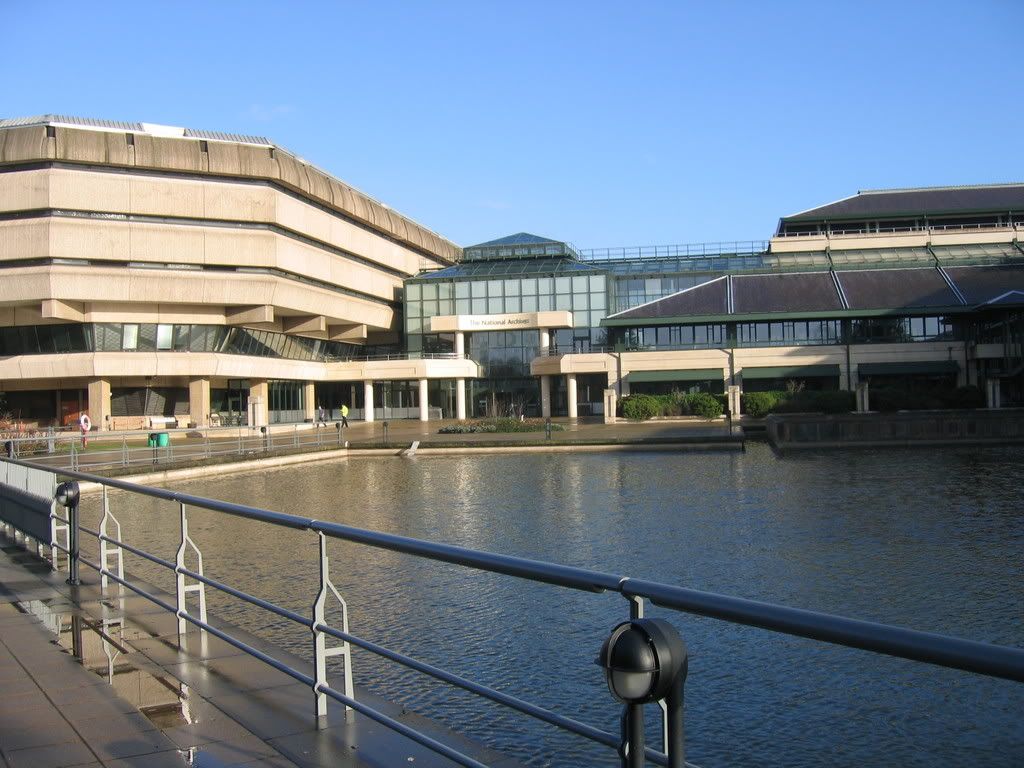I wanted to see if TNA was similar to different to NARA: I wasn't sure what kind of tour we would be given: I do want to know more about how TNA organizes their records, which records are most requested, whether they have the papers of Parliamentarians as well as the official functions of the UK government. At the Center for Legislative Archives the papers of Senators and Congressmen are not part of their mandate so I wondered how personal papers of politicians were treated in the UK?
The National Archives is the "UK government's official archive, from Domesday to websites." Their collections contain over 1,000 years of British (English, Welsh, Scottish, Irish and imperial) history. TNA "give[s] detailed guidance to government departments and the public sector on information management and advise others about the care of historical archives." (TNA "About us") Their collection includes over 11 million records from vellum, parchment and paper to electronic records and websites as well as photographs, posters, maps, drawings and paintings. One interesting point: The National Archives has developed a system to take users from defunct government websites (dead links) to a site that includes an archived version of that site. Users are informed that they are not on an active site, but they are able to view any information that was available on the original website (as it was at the time of the site's preservation.) They currently have over 1,000,000,000 online documents available through their Government Web Archive and the staff is working to create best practices for website and email archiving within the UK government.
The bus ride to TNA was much longer than I thought--originally housed on Chancery Lane in what is now the King's College's Maughan Library the archives moved to West London in 1977 when the Public Records Office was combined with the Historic Manuscripts Commission. While the new location is larger and geared toward storage of the vast and varied records held by TNA, the building, as you will see below, is less than inspiring (at least when compared to the Maugham). Note: this is an opinion given by a 19th century political historian/archivist who loves modern sculpture but takes issue with the minimalist nature of modern architecture.
New The National Archives:

Old Public Records Office Building at Chancery Lane (current King's College Maughan Library, which we will be visiting later this month)

As you can see, the original building had a very different architectural feel. The current TNA was built to connect two existing buildings with a central entry and courtyard. It fulfills the purpose but is less aesthetically pleasing than the British Museum's main gallery.
But, as we know, other than the protection and environmental controls, archives are about what is on the inside, not the outside and TNA has an amazing collection. All the records of Parliament, of the UK governmental and associated organizations, maps, birth, marriage and death records, house history, are housed at TNA. On the tour we viewed a map of London from before the Great Fire with illustrations of the original London Bridge. Other exhibits we were shown were Exchequer rolls, maps of South Africa--there are rows of map drawers divided by continent, region and country. Most of this information you can find at the National Archives website.
TNA has an excellent homepage that provides information about their holdings, their research protocols, and frequently asked questions.
There were two things that I found most interesting--and both related to the use of space. Unlike the behind the scenes at Archives I in D.C.(I have not seen Archives II's stacks), TNA had enough space between most shelving units for at least two men to walk through side-by-side and enough room for golf carts between aisles and sections. At NARA I usually can't walk up the aisle without bumping an elbow or a hip into something. Second: they have these ingenious reader's desks--eight people can sit where 4 do in most U.S. reading rooms. They are a triumph of geometry and creativity for space saving, though they are an unfortunate 70s avocado green color.
One other surprise--and suggestion that perhaps the Brits trust their researchers more than Americans--is the fact that readers retrieve their own records when they are brought up by the pages--they are placed in plexiglass lockers with the reader's number and they pick them up. I could not imagine that in the U.S. Researchers are often barely trusted to carry the books from cart to table depending on the archive.
Overall, I was impressed by TNA, and our guide, was diligent, informed and excited to show us his institution, I only wish we had more time. What better way than to spend a day opening map drawers or searching through manuscripts? Ok, there are a few better ways, but this would definitely be in my top three.
Sources:
The National Archives photograph: http://beerblog.motime.com/archive/2006-12
Maugham Library Photograph and text by Jacqueline Banerjee http://www.victorianweb.org/victorian/art/architecture/london/121.html
No comments:
Post a Comment